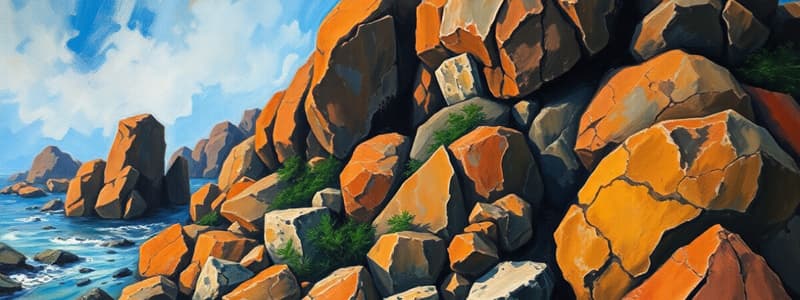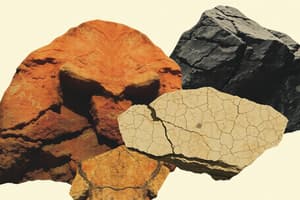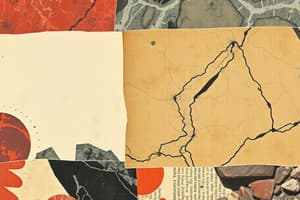Podcast
Questions and Answers
Explain how the process of metamorphism can lead to the formation of both foliated and non-foliated metamorphic rocks, emphasizing the role of pressure and temperature.
Explain how the process of metamorphism can lead to the formation of both foliated and non-foliated metamorphic rocks, emphasizing the role of pressure and temperature.
Metamorphism involves the transformation of existing rocks under intense heat and pressure. Foliated metamorphic rocks, like schist and gneiss, form when pressure is directed, causing mineral alignment. Non-foliated rocks, like marble and quartzite, form when pressure is more uniform, leading to recrystallization without alignment.
Describe the role of weathering and erosion in the rock cycle, explaining how they connect the processes of rock formation and destruction.
Describe the role of weathering and erosion in the rock cycle, explaining how they connect the processes of rock formation and destruction.
Weathering breaks down rocks into smaller fragments, either physically or chemically. Erosion then transports these fragments, moving them from their original location. This process exposes underlying rocks to further weathering and erosion, contributing to the continuous cycle of rock formation and destruction.
How does the concept of plate tectonics influence the rock cycle, specifically in relation to the formation of igneous rocks?
How does the concept of plate tectonics influence the rock cycle, specifically in relation to the formation of igneous rocks?
Plate tectonics drives the movement of Earth's crust, leading to the formation of volcanoes and magma chambers. The cooling and solidification of this magma results in the formation of igneous rocks. Subduction zones, where one plate slides beneath another, also contribute to the formation of igneous rocks as the descending plate melts.
Compare and contrast the formation of sedimentary rocks and metamorphic rocks, focusing on the specific conditions and processes involved.
Compare and contrast the formation of sedimentary rocks and metamorphic rocks, focusing on the specific conditions and processes involved.
Discuss the importance of the rock cycle in understanding Earth's history, emphasizing its role in revealing past geologic events and environmental conditions.
Discuss the importance of the rock cycle in understanding Earth's history, emphasizing its role in revealing past geologic events and environmental conditions.
Flashcards
Igneous Rock
Igneous Rock
Rock formed from the solidification of molten magma or lava.
Sedimentary Rock
Sedimentary Rock
Rock formed by the accumulation of sediments over time and often contains fossils.
Metamorphic Rock
Metamorphic Rock
Rock changed by heat, pressure, or chemically over time from existing rock types.
Rock Cycle
Rock Cycle
Signup and view all the flashcards
Weathering
Weathering
Signup and view all the flashcards
Study Notes
Igneous Rocks
- Igneous rocks form from the cooling and solidification of magma or lava.
- Magma is molten rock beneath the Earth's surface, while lava is molten rock that erupts onto the surface.
- The rate of cooling affects the crystal size of the resulting rock. Fast cooling produces fine-grained rocks, slow cooling produces coarse-grained rocks.
- Intrusive igneous rocks cool slowly beneath the surface, forming large crystals (e.g., granite).
- Extrusive igneous rocks cool quickly at the surface, forming small crystals (e.g., basalt).
- Key characteristics include mineral composition and texture.
- Common igneous rocks include granite, basalt, obsidian, and pumice.
Sedimentary Rocks
- Sedimentary rocks form from the accumulation and cementation of sediments.
- Sediments include minerals, fragments of other rocks, and organic matter.
- These sediments are transported by water, wind, or ice.
- Deposition occurs where the transporting agent loses energy.
- Compaction and cementation of these sediments lead to the formation of sedimentary rocks.
- Types of sedimentary rocks include clastic (e.g., sandstone, shale), chemical (e.g., limestone, rock salt), and organic (e.g., coal).
- Fossils are frequently found in sedimentary rocks.
Metamorphic Rocks
- Metamorphic rocks are formed from pre-existing rocks that have been changed by heat, pressure, or chemical reactions.
- Heat and pressure deep within the Earth can significantly alter the minerals and texture of rocks.
- "Parent" rocks can be igneous, sedimentary, or even other metamorphic rocks.
- Metamorphic rocks demonstrate a wide range of textures and structures, reflecting the specific conditions of their transformation.
- Examples of metamorphic rocks include marble (from limestone), slate (from shale), and gneiss (a foliated rock).
The Rock Cycle
- The rock cycle is a continuous process that describes the transitions among the three main rock types.
- Magma cools and solidifies to form igneous rocks.
- Weathering and erosion breaks down rocks into sediments
- Sediments compact and cement to create sedimentary rocks.
- Heat and pressure transform rocks into metamorphic rocks.
- Metamorphic rocks can be melted to form magma, or weathered and eroded into sediments to restart the cycle.
- The processes involved in the rock cycle are driven by Earth's internal and external forces.
- The rock cycle is a dynamic system, constantly changing and recycling the Earth's materials.
Studying That Suits You
Use AI to generate personalized quizzes and flashcards to suit your learning preferences.




